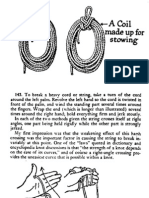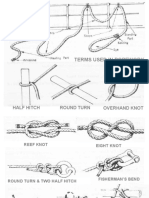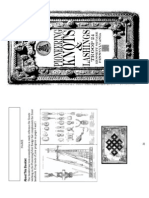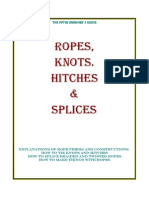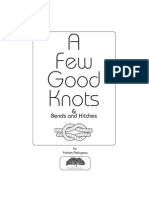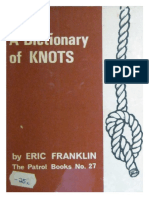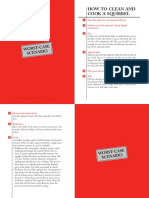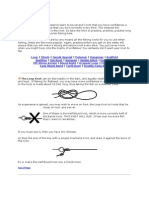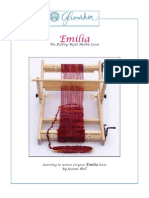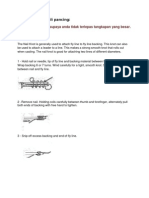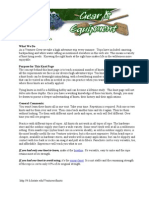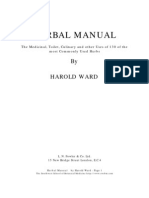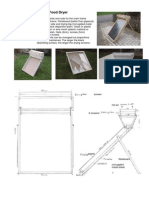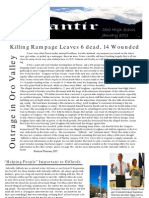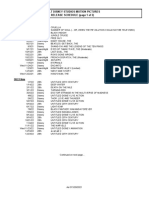Tying Farm Knots
Tying Farm Knots
Uploaded by
sanyu33333Copyright:
Available Formats
Tying Farm Knots
Tying Farm Knots
Uploaded by
sanyu33333Original Description:
Copyright
Available Formats
Share this document
Did you find this document useful?
Is this content inappropriate?
Copyright:
Available Formats
Tying Farm Knots
Tying Farm Knots
Uploaded by
sanyu33333Copyright:
Available Formats
Working with Heifers
Tying Farm Knots
A rope is one of the most common of tools used to restrain animals. Unfortunately, most people never learn which knots are most efficient to use in given situations. Practice tying the knots presented here as you read through the descriptions. First, lets define the parts of the rope:
Square Knot The square knot is simply two overhand knots tied one after the other. The sequence must be correct. Remember: right over left then left over right as you tie the overhand knots. Or the opposite: left over right then right over left. The knot should have a square appearance. The square knot is a strong, small knot used to tie the ends of two ropes together. When splicing two balls of twine together in a baler, a square knot is used. Under tension, a square knot will tighten and may be difficult to untie.
Overhand Knot An overhand knot is the simplest of all knots. Generally, it is not used by itself but is the first step in tying more complex knots. It may be used by itself to keep the end of the rope from unraveling or to provide a knob or hand hold in a rope. Granny Knot The granny knot is an undesirable knot that is illustrated here so that you recognize it. It has no useful purpose. People mistakenly tie it when what they really want is a square knot. It is two overhand knots like the square knot but is bigger and not as strong. It is tied by going left or right and then left over right again, or by beginning right over left and going right over left with the second overhand knot.
51
Working with Heifers
Reefers Knot The reefers knot is just a square knot with a single bow in it so that it can be untied. A common use might be to tie a gate open or closed. Another closely related knot is the bow knot which is used to tie shoe laces.
Honda Knot The honda knot is simply one overhand knot inserted into another. Like the bowline knot, it will give a nonslip loop. It is used to form the small loop for the end of a lariat to pass through and because of its nonslip property may be used to tie a rope around an animals neck.
Surgeons Knot Another variation of the square knot is the surgeons knot. This knot has the advantage of the first overhand knot holding while the second is being tied. When putting in the first overhand knot, wrap 2 or 3 times instead of once. This provides additional friction between the rope, making it easier to hold. The surgeons knot is used when the rope is under tension as you are trying to tie it. It is used when retying a bale, tying an overstuffed package or during suturing.
Bowline Knot The bowline knot is the preferred knot when tying a rope around any part of an animals body because it wont slip and tighten around the animal. Also, the knot is relatively easy to untie. First, place a loop in the rope where the knot is to be tied. The loop should be pointed toward the free end and the working part should be to the back. Next, insert the free end of the rope through the loop from the back. Go around the working part of the rope and back through the loop and tighten. To help you remember, there is a story that goes along with the knot: The rabbit jumps out of the hole, runs around the front and down behind the tree and jumps back in the hole. With a little practice, it is a knot that can be tied quickly.
52
Working with Heifers
Ring Knot The ring knot is used to fasten a ring to a rope or can be quickly formed and dropped over or tied to a post. For a drop over ring knot, make a bight in the rope, grasp the two strands with one hand and pull the bight over your hand. The resulting double loop can be dropped over a post.
Quick Release Knot The quick release knot is frequently used when tying a haltered animal to a post or fence. It can be released very quickly should the need arise, although it may tighten up to the point where the bow is hard to pull out. To prevent the animal from releasing itself, insert the free end through the bow after the knot is tied.
Double Sheet Bend Knot The double sheet bend knot is used to tie two ropes of unequal size or stiffness together. If the ropes are similar, the simpler square knot should be used. To tie, form a bight in the larger or stiffer of the two ropes, then run the lighter rope into the bight, wrap it around the heavier rope and then string it between itself and the strands of the bight as illustrated.
Double Half Hitch The double half hitch is the preferred knot if a haltered animals head needs to be snugged up tight to a post such as for dehorning or other operations. The double half hitch cannot be released as quickly as a quick release knot, but is easier to tie while keeping the rope tight and is a more secure knot. It doesnt tighten up on itself so is easy to untie.
53
Working with Heifers
Making a Rope Halter
Rope halters are needed occasionally on all dairy farms. They are inexpensive to buy, but even so, it is worthwhile to know how they are made because it may be inconvenient to run to the farm supply store when one is needed. In addition, if you know how they are made, it will be easier to repair or adjust one if the need arises. To make a halter, start with a three strand rope 12 to 15 in length. A 3/8-inch rope is suitable for calves. Halters for yearlings or cows are made from 7/16 or 1/2 inch rope. Finishing the Rope Ends The first step is to finish the ends of the rope to prevent them from unraveling. Only one end needs to be finished if alternative 2 is used to finish the nose piece of the halter. Following are several methods used to finish the end of a rope: 1. The quickest, but not the best, way to finish a rope is to put an overhand knot in the end of the rope. The figureeight knot as illustrated is actually a more secure knot.
Hold the rope in one hand to prevent it from unraveling further. Take the upper most strand and bend it between the other two, forming a bight. Wrap the next strand down around the bight. Insert the last strand into the bight. Carefully pull on each of the strands to tighten the crown knot. It should be a very symmetrical knot.
2. Dipping 1-2 of the rope into an oil based paint or varnish works well except for polypropylene rope. It should dry for 24 hours before it is used. 3. The ends of nylon, dacron and polypropylene rope can be heated to fuse the fibers together. If using a flame, hold the end of the rope from the flame so that the rope heats thoroughly instead of only the outer fibers. The fibers should melt and stick together. Wear an old pair of heavy leather gloves so that you can shape the hot end in case a large knob or sharp edge results. 4. Metal wraps, hog rings, or heavy wire or wire staples bent around the rope will prevent it from unraveling if done properly. Be certain that there are no sharp edges when you are finished. 5. You can crown the rope by using a crown knot and back splicing. Start by unraveling about four inches of the rope.
Back splicing is now done to complete the crowning of the rope. Hold the knot in one hand and twist the rope to loosen the strands. Start with any strand and bend it over the strand next to it and under the next strand, which should be itself. Do the same with the other two strands. Bending them over one strand down the rope and under themselves. Continue lacing the strands over one and under one down the rope so that each strand is tucked under 3 times. Trim the frayed ends.
54
Working with Heifers
Making the Halter Finishing the Nose Piece (Alternative 1)
1. Measure out 12 from the end of the rope for the nose piece for a calf-sized halter. Twist the rope to open up the strands. Insert the short rope under one strand, leaving a loop twice the diameter of the rope.
3. Grasp the nose piece near the end with one hand and 2-3 inches further down the rope with the other. Twist the rope between your hands to open the strands, then push your hands together. The strands should buckle and fold over, forming three loops. Line up the loops and put a stick the diameter of the rope through them to keep them in place.
2. To secure this loop, open up the strands of the nose piece near the loop. Push the long end of the rope under the two opened strands and pull it through until it is tight. 4. Put the long end of the rope through the loops one at a time, starting with the loop furthest from the short end. Remove the stick as you go. After that is complete, run the long end of the rope through the eye loop to complete your halter.
55
Working with Heifers
Finishing the Nose Piece (Alternative 2) When putting the halter on an animal, the lead rope should be on the left hand side of the animals head (Figure 1). The part of the halter that tightens through the loop should be under the animals chin. The length of the nose piece will determine how high it rides on an animals face. A short nose piece will cause the halter to ride lower on the nose and will give you more control when leading the animal. Finished nose pieces should be about 7 long for calves and up to 14 long for cows.
3. With this method, the short end of the rope should not be finished. Bend about five inches over the head piece as shown. Unravel the end of the rope. Back splice the strands into the nose piece as previously illustrated on page 55. First take the center strand and insert it under the first strand of the nose piece. Repeat with the second strand. Keep the loop tight around the rope of the head piece.
Figure 1
4. Work around the rope, lacing the strands over one and under one so that each strand is tucked at least three times. Trim the frayed ends. After the splice is complete, run the long end of the rope through the eye loop to complete the halter.
56
You might also like
- Basic Book of Knots and LashingsDocument38 pagesBasic Book of Knots and LashingsREBogart93% (40)
- Practical Paracord Projects: Survival Bracelets, Lanyards, Dog Leashes, and Other Cool Things You Can Make YourselfFrom EverandPractical Paracord Projects: Survival Bracelets, Lanyards, Dog Leashes, and Other Cool Things You Can Make YourselfNo ratings yet
- Fishing KnotsDocument8 pagesFishing KnotsOmar Muñoz100% (1)
- 332 Indian Food Recipes Sanjeev KapoorDocument159 pages332 Indian Food Recipes Sanjeev Kapoorpramod195578% (9)
- CuttoperfectionDocument2 pagesCuttoperfectiondeniz9h9seyin9kaya100% (1)
- Wavin' FlagDocument2 pagesWavin' FlagMalujaneNo ratings yet
- Tying It All TogetherDocument2 pagesTying It All TogetherBushcraftOzNo ratings yet
- Knots LashingsDocument35 pagesKnots LashingsCJPerezNo ratings yet
- Rope WorkDocument19 pagesRope WorkAntonis Ggg100% (3)
- Craft of The Stringer PDFDocument8 pagesCraft of The Stringer PDFMichael Eugene ChurchNo ratings yet
- Ropes, Knots, Ladders, Lashings & AnchoragesDocument76 pagesRopes, Knots, Ladders, Lashings & AnchoragesRicardo_Suffre_8842100% (5)
- Useful Knots For CampersDocument6 pagesUseful Knots For Campersjohn mcbrideNo ratings yet
- Knots TechniquesDocument2 pagesKnots TechniquesFirman Rafif RaniNo ratings yet
- Double Cobra Knot Paracord BeltDocument12 pagesDouble Cobra Knot Paracord BeltTheHairyOneNo ratings yet
- Terms Used in Ropework: Half Hitch Round Turn Overhand KnotDocument22 pagesTerms Used in Ropework: Half Hitch Round Turn Overhand Knotjoshigauta100% (1)
- Knots, SplicesDocument8 pagesKnots, SplicesSazali Ramli100% (1)
- Knots and StringDocument18 pagesKnots and Stringdamchilbert100% (10)
- Wilderness StretchersDocument3 pagesWilderness StretchersUros SmiljanicNo ratings yet
- To Hunt: LearningDocument16 pagesTo Hunt: LearningSid ZorkNo ratings yet
- Knotty KnotsDocument35 pagesKnotty KnotsRalf SnellNo ratings yet
- Ropes CraftDocument28 pagesRopes Craftbitt100% (7)
- Ropes and Knots (Rev 3)Document51 pagesRopes and Knots (Rev 3)ecsalom100% (6)
- Whipping PDFDocument1 pageWhipping PDFresisterNo ratings yet
- 25 Types of Knots That You Need To KnowDocument31 pages25 Types of Knots That You Need To KnowCindy SaquilonNo ratings yet
- Fibre Ropes, Knots, HitchesDocument26 pagesFibre Ropes, Knots, HitchesMaricris de GuzmanNo ratings yet
- Rope SplicingDocument33 pagesRope SplicingnkuzmikNo ratings yet
- Knot GuideDocument25 pagesKnot GuideRyan SmithNo ratings yet
- Paracord Wrist Lanyard Made With The Snake KnotDocument14 pagesParacord Wrist Lanyard Made With The Snake Knotkevinpettit100% (1)
- A Few Good KnotsDocument42 pagesA Few Good KnotsDavid Enrique Mendez100% (1)
- Knot, Hitch & Lashing: Lencana KeahlianDocument13 pagesKnot, Hitch & Lashing: Lencana KeahlianWaeril WaeNo ratings yet
- A Dictionary of KnotsDocument32 pagesA Dictionary of KnotstLzmS2367% (3)
- Knot & LashesDocument34 pagesKnot & Lashestiqah mlNo ratings yet
- Gilcraft 7 KnottingDocument46 pagesGilcraft 7 KnottingthumbedmonkeyNo ratings yet
- How To Clean and Cook A SquirrelDocument2 pagesHow To Clean and Cook A SquirrelKOOPER FRUITTENo ratings yet
- Rope Making From PALFDocument8 pagesRope Making From PALFAsia CtNo ratings yet
- PE KnotsDocument8 pagesPE KnotsAnonymousNo ratings yet
- CASA KNOTS - Parts and Bights ExplanationsDocument15 pagesCASA KNOTS - Parts and Bights Explanationsogny0100% (1)
- Fishing KnotsDocument13 pagesFishing KnotscockofclanNo ratings yet
- Rope Man ShipDocument5 pagesRope Man ShipJorelyn FriasNo ratings yet
- Knots Tying Manual - Step by Step Guide To Knots Tying - Stopper Knot, Bowline, Double BowlineDocument173 pagesKnots Tying Manual - Step by Step Guide To Knots Tying - Stopper Knot, Bowline, Double BowlineDjzordan100% (1)
- LectureDocument26 pagesLectureAyesha HashmatNo ratings yet
- Knots2 JohnSandersMay2014Document81 pagesKnots2 JohnSandersMay2014Abad Carrillo0% (1)
- Essential KnotsDocument42 pagesEssential Knotsstummel6636No ratings yet
- Boating Knots PDFDocument2 pagesBoating Knots PDFJesus RiveroNo ratings yet
- The Fireman'S Coil The Sailor'S CoilDocument20 pagesThe Fireman'S Coil The Sailor'S CoilPresenti SergheiNo ratings yet
- Fishing Knots, Swivels, SinkersDocument41 pagesFishing Knots, Swivels, SinkersRyan Rode100% (1)
- Tie Your Own Rope HalterDocument5 pagesTie Your Own Rope HalterDavid CieloNo ratings yet
- Knotty AffairDocument13 pagesKnotty AffairRakesh BaptistaNo ratings yet
- Emilia Instruction 4 EmailDocument10 pagesEmilia Instruction 4 EmailM8R-ebc5upNo ratings yet
- Rope Man ShipDocument39 pagesRope Man ShipKellyAustria100% (2)
- Fact Sheet Simple KnotsDocument6 pagesFact Sheet Simple KnotsLary BagsNo ratings yet
- Cara Mudah Mengikat Tali PancingDocument5 pagesCara Mudah Mengikat Tali PancingAli_Hashim_5097100% (1)
- Seamanship 1Document4 pagesSeamanship 1Adrian BelmonteNo ratings yet
- Know Your KnotsDocument10 pagesKnow Your Knotscpt_galeNo ratings yet
- KnotDocument2 pagesKnotPrincess Danica PurciaNo ratings yet
- 10 Essential Knots Everyone Should KnowDocument17 pages10 Essential Knots Everyone Should KnowKevin HuangNo ratings yet
- Making A Flemish BowstringDocument12 pagesMaking A Flemish Bowstringraydarkhorse100% (2)
- Cara Simpulan Mata KailDocument9 pagesCara Simpulan Mata KailmilaminNo ratings yet
- Essential Knots For Horse PeopleDocument16 pagesEssential Knots For Horse PeoplebanzaibobNo ratings yet
- Fishing KnotsDocument6 pagesFishing KnotsalyboscanNo ratings yet
- Knot HandoutDocument8 pagesKnot HandoutkristinvanNo ratings yet
- How To Tie Knots: What We DoDocument13 pagesHow To Tie Knots: What We DoGingko27No ratings yet
- Drying Fruits and VegetablesDocument32 pagesDrying Fruits and Vegetableslokikg100% (6)
- Manual de Plante MedicinaleDocument115 pagesManual de Plante Medicinalevrajitorul100% (3)
- Ethnobotany of Potawatomi PDFDocument130 pagesEthnobotany of Potawatomi PDFurania22000No ratings yet
- How To Build A Solar Food DryerDocument2 pagesHow To Build A Solar Food Dryersanyu33333No ratings yet
- Boyscout Cookbook PDFDocument44 pagesBoyscout Cookbook PDFsanyu33333No ratings yet
- Aid To SurvivalDocument112 pagesAid To Survivalsanyu33333100% (1)
- Bread and The Principles of Bread MakingDocument52 pagesBread and The Principles of Bread Makingtobiasaxo565367% (3)
- Complete Sewing InstructionsDocument100 pagesComplete Sewing InstructionsThomas Plummer85% (13)
- Result Code 3Vf-Lgc-Rlx Black Spindle Exotic Sniper Rifle: Star Antigen EmblemDocument2 pagesResult Code 3Vf-Lgc-Rlx Black Spindle Exotic Sniper Rifle: Star Antigen EmblemPavel OrNo ratings yet
- I. Phonetics (3) Chọn từ có phần gạch chân phát âm khácDocument3 pagesI. Phonetics (3) Chọn từ có phần gạch chân phát âm khácHuy NhatNo ratings yet
- Smartop Upright 3.0 Arctic Installation Instructions 3-18-20Document2 pagesSmartop Upright 3.0 Arctic Installation Instructions 3-18-20kimba worthNo ratings yet
- Drug PDFDocument159 pagesDrug PDFRantyRizkiNo ratings yet
- Unit 6 Basic Test Answer Key: Listening Language FocusDocument2 pagesUnit 6 Basic Test Answer Key: Listening Language Focusrayyanas4052No ratings yet
- Killing Rampage Leaves 6 Dead, 14 Wounded: CDO High School January 2011Document8 pagesKilling Rampage Leaves 6 Dead, 14 Wounded: CDO High School January 2011CDOPalantirNo ratings yet
- The Hero'sjourneyDocument17 pagesThe Hero'sjourneyAsh JamesNo ratings yet
- Walt Disney Studios Motion Pictures RELEASE SCHEDULE (Page 1 of 2)Document2 pagesWalt Disney Studios Motion Pictures RELEASE SCHEDULE (Page 1 of 2)Jaime Andrés Bailón MielesNo ratings yet
- Pledge DatabaseDocument24 pagesPledge DatabaseVikramNo ratings yet
- Enlisted Record BriefDocument1 pageEnlisted Record BriefJuanRomeroNo ratings yet
- ResultBook - Youth All - 638086982828838932Document42 pagesResultBook - Youth All - 638086982828838932raj1269No ratings yet
- Free++stb+emu+codes+01 11 2024Document104 pagesFree++stb+emu+codes+01 11 2024enzzoo43cloneyNo ratings yet
- Deepika Padukone Net WorthDocument3 pagesDeepika Padukone Net WorthAnne GreerNo ratings yet
- Sheldon Begay Work ResumeDocument2 pagesSheldon Begay Work Resumeapi-333340105No ratings yet
- D1 T1-T8 Students ListDocument10 pagesD1 T1-T8 Students ListPushkraj pathakNo ratings yet
- Latin TechniqueDocument12 pagesLatin TechniqueShiny WaghmodeNo ratings yet
- JEP Journal of Exercise Physiology: Online OnlineDocument17 pagesJEP Journal of Exercise Physiology: Online OnlineTomas Rivera100% (2)
- ThrowersDocument8 pagesThrowersyejminshiNo ratings yet
- HMK300E Brochure English 4 PDFDocument8 pagesHMK300E Brochure English 4 PDFJo2020MeNo ratings yet
- Head Onlen AimbotDocument2 pagesHead Onlen Aimbotikangfadli1950% (2)
- OOP Finals - AFFIN 100PLUS Junior Elite Tour Finals 2024Document1 pageOOP Finals - AFFIN 100PLUS Junior Elite Tour Finals 2024Nizam ShahNo ratings yet
- EF4E Pre-Intermediate WB - Unit 1Document12 pagesEF4E Pre-Intermediate WB - Unit 1Haron Al-kahtaniNo ratings yet
- RanksDocument1 pageRanksapi-3769884No ratings yet
- The - Legend - of - Zelda - Main - Theme - Medley - 25th - Anniversary - UPDATED - 71320-Violin 2Document2 pagesThe - Legend - of - Zelda - Main - Theme - Medley - 25th - Anniversary - UPDATED - 71320-Violin 2fernandapazramirezpizarroNo ratings yet
- Afl Round 11 - Saturday-Pacific RacingDocument1 pageAfl Round 11 - Saturday-Pacific RacingjoanalcarazNo ratings yet
- Bobcat s250Document3 pagesBobcat s250Tarek TorbeyNo ratings yet
- Exercise 1. Mark The Word or Phrase Which Does Not Contain The Same Sound As The Other ThreeDocument8 pagesExercise 1. Mark The Word or Phrase Which Does Not Contain The Same Sound As The Other Threehien thuyNo ratings yet
- I'm Still StandingDocument2 pagesI'm Still StandingShayne Gulle100% (1)










